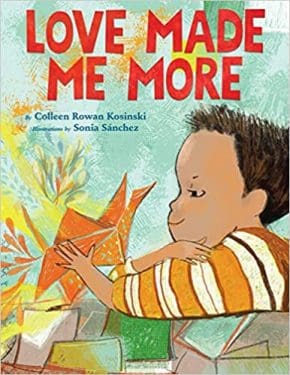
An unexpectedly heartfelt tale of a friendship between a boy and an origami crane that continues throughout the boy’s life.
When a boy’s grandmother shows him how to fold an origami crane, the boy and crane become instant friends. They sail around the room and play, but the crane also watches over the boy and comforts him in a time of loss. The crane is always on the boy’s nightstand―it’s the last thing he sees each night and the first thing he sees each morning.
Over time, the boy grows older, and the crane becomes dusty. But even when the boy becomes a young man, the crane plays a part in the most important moments of his life. And one day, just like his grandmother before him, the man shows his own son how to fold origami as the crane looks on.
Beautifully written and illustrated, this story of an unlikely friendship that spans generations reminds us how much one moment with a loved one can affect our lives in the most meaningful way.
Publishing Dec 13 2022.
Reviews
Kirkus, Nov 16 2022:
“Sánchez’s eye-catching digital illustrations, rendered in a vivid palette of warm reds, oranges, and yellows as well as cool blues, present striking angles reminiscent of the paper crane’s folds… This storytime selection may encourage both questions about growing up and the role of a child’s treasures in their changing lives. A visually and narratively compelling tale of childhood friendships that evolve and grow.” —Kirkus Reviews
A square of colorful paper becomes a cherished lifelong treasure.
A boy with brown skin and brown hair makes origami with a loving older adult who has tan skin and black hair. The boy folds a crane out of orange, white, and blue paper, a recurrent color motif. The boy’s imagination brings the crane to life, and soon they are inseparable. With Kosinski’s concise, expressive prose (“I am his Origami Crane, and he is My Boy”), the crane narrates their poignant friendship. During times of sadness (when, for instance, it’s implied the beloved elderly adult has died), the crane offers comfort to the grieving boy; during a scary storm, the crane brings solace. Time passes, and the boy meets a girl with dark brown skin and dark hair who becomes his wife. The crane initially experiences jealousy at being replaced before finding renewed purpose with their new baby boy. Sánchez’s eye-catching digital illustrations, rendered in a vivid palette of warm reds, oranges, and yellows as well as cool blues, present striking angles reminiscent of the paper crane’s folds. A loose line and effective use of light and shadow draw in readers and invite repeated viewings. This storytime selection may encourage both questions about growing up and the role of a child’s treasures in their changing lives.
A visually and narratively compelling tale of childhood friendships that evolve and grow. (Picture book. 3-8).
School Library Journal Starred Review:
“Imaginative and tender, this story may inspire conversations or projects around special objects in readers’ families.” —School Library Journal, Starred Review
PreS-Gr 2–A piece of orange paper with white and blue spots narrates its experience of becoming an origami crane belonging to “My Boy,” living in a special place of honor on his nightstand: “I am the last thing he sees each night and the first thing he sees each morning.” But the boy is growing up: one day the crane’s place is usurped by a photo of the boy with a girl, and later, the boy writes a marriage proposal on the crane. Presently, the crane soars from a wire in a mobile over a baby’s crib, understanding finally that “I was never just a piece of paper….Love has made me so much more.” As in Henry Cole’s One Little Bag, a precious object is imbued with deep significance from one generation to the next; here, it’s centered as the main character, acknowledging the importance—even sentience—children attribute to their special treasures. The illustrations are lively and full of movement: Boy and Crane sailing around the room, the Girl leaping into the Boy’s arms, a curtain blowing in the breeze. The items that clutter the boy’s night stand as he ages show how his interests change over time, from origami to video games to guitar. The Boy has warm brown skin and short brown hair; the Girl is Black with long curly hair.VERDICT Imaginative and tender, this story may inspire conversations or projects around special objects in readers’ families; recommended for all collections.
“Isabel is a lovely person; always professional, kind and thoughtful. She listens and advises, drawing from a great instinct and experienced knowledge of the publishing world. Isabel is always positive and her guidance has been and is always invaluable. I am delighted to be represented by Isabel.”
Graham Howie, Creative Authors Client